 Regia Marina – 8 destroyers:
Regia Marina – 8 destroyers:Giuseppe La Masa, Giacinto Carini, Benedetto Cairoli, Angelo Bassini, Nicola Fabrizi, Giuseppe La Farina, Agostino Bertani, Giacomo Medici.
Built 1916-1919, ww1, ww2, cold war until 1958
WW2 Italian Destroyers
Poerio | Aquila | Mirabello | Leone | Sella | Sauro | Turbine | Navigatori | Freccia | Folgore | Maestrale | Oriani | Soldati | Medaglie d’OroWW2 Italian Torpedo Boats
Indomito | Audace | Audace(ii) | Pilo | Sirtori | La Masa | Generali | Palestro | Curtatone | Albatros | Spica | Pegaso | Ciclone | ArieteThe La Masa class were eight destroyers all ordered in 1916 at Odero Yard in two batches, six laid down in 1916 and two in 1917. Two were completed in 1917, three in 1918, seeing some action in WW1, and the last three in 1919. They were all active in WW2 as torpedo boats (from 1929). In the first World War, one ship was lost in a collision and in the Second World War, two were sunk in air attacks while, one by a mine, two more scuttled under German hands. The last two served in the cold war as minesweepers with the Marina Militare until decommissioned in 1957–1958.
Development
The La Masa class were a developement of the previous Sirtori class destroyers. Four were ordered in 1915, four in 1916, all at Odero shipyard in Sestri Ponente, near Genoa. Conway’s precised they were the 3rd wartime series of “improved Indomitos” and the penultimate “tre pipe” or “three funnels” as they were succeeded by the Generali class, also eight ships ordered in 1917, but only seven laid down in 1918 but completed well after the war in 1921-22. They repeated the Sirtori will aletrations such as only four 4-inches guns, 102 mm Schneider-Armstrong 1917 L/45 guns (45 caliber gave them more impact and range, this was the important added value, for some extra weight), two bow ones side by side, two aft one behind the other on the centre line. These were Italian-made licensed copies of the British QF 4in Mk V gun, a proven rapid fire model (see the full development below).
The secondary armament was also changed and instead two 40 mm they had more powerful 76.2 mm (3 in) L/40 Ansaldo anti-aircraft guns, comleted for close quarters by four 6.5 mm (0.26 in) Colt-Browning light machine guns. Like the previous class however they carried four 450 mm (18 in) torpedo tubes in twin mounts and could be loaded with ten mines aft. The reduction from six to four guns and repositioning was due to stability worries, which were justified due to the heavier guns. Engineers at Odero thus had two placed on the center line, with broadside of three guns, still.
All the remaining design details were the same as the Sirtori class:
Design of the class
Hull and general design
Same hull, identical dimensions, on a similar, if reduced displacement of 785 tonnes standard and 851 tonnes fully loaded versus 790-850 tonnes. This corresponded to 798 t standard and 865 t short tons full load. They measured 73.5 meters overall (241 ft) for 7.3 meters (24 ft) wide and with a 2.8 m (9 ft 2 in) draught.
The forecastle represented 1/4 of the total lenght and they had the typical inverted clipper bow (longer at the waterline and chin) improving seekeeping qualities, broad prow with moderate flare, and a long, mostly same-beam hull ending in a broad rounded prow. The stern rudder protruded far aft, still attached directly on the poop and using a backup steering system. The sole superstructure was the bridge forward, with a small map room topped by an enclosed, fully glassed bridge, and an open bridge above.
All windows were hinged to be lifted up and ventilate the bridge in summer. Single mainmast forward aft of the bridge, which also supported the main telemeter for the fire control. The mast was composite, witrh the lower section supporting a spotting top. It supported radio cables, set on the small aft mast. Both and the three funnels were raked. The middle funnel was larger than the others due to the double truncating. There was a double steering wheel aft, just behind the aft mast. There was also a single light projectors on the bridge’s roof and two small morse projectors on the bridge’s wings. The La Masa class ships carried a complement of 4 officers and 74 ratings for which they had two service boats and a serie of life rafts.
Powerplant
Their machinery was a repeat of the Sirtori again, comprising four oil-fired Thornycroft boilers feeding two Tosi steam turbines delivering 15,500 shp (11,600 kW). This power was passed on two shafts. Top speed as commissioned reached 33.6 knots (62.2 km/h; 38.7 mph) down to just 30 knots (56 km/h; 35 mph) as World War II started due to these wearing out in service. Fuel storage was 150 tons of oil, for a range of 2,230 nmi (4,130 km; 2,570 mi) at the cruising speed of 12.5 knots (23.2 km/h; 14.4 mph), probably less in 1940 for extra leaks and greater consumption.
Armament
4-in/45 Modello 1917
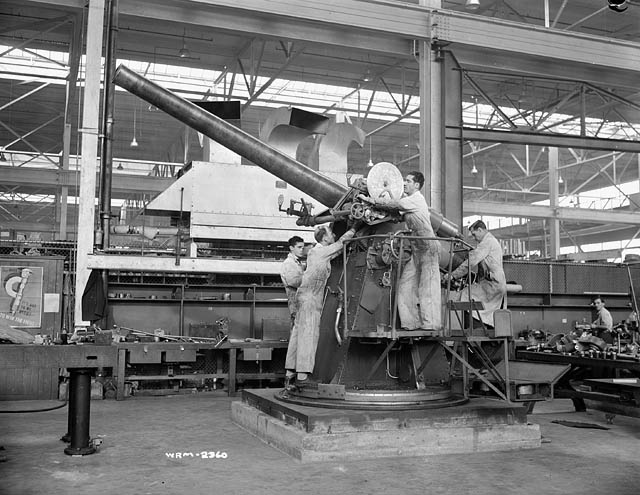
Four 102 mm (4 in)/45 Schneider-Armstrong modello 1917 single Open Mount were installed in line to distributed weight and broadside, one single forward on the forecastle, three on the weather deck, with an axial one aft, two aft amidship on bandstands either side. Horizontal or vertical sliding breech block. Later one was removed a single one was kept on an axial bandstand.
Cannone da 102/45 Schneider-Armstrong Modello 1917
The Schneider-Armstrong Model 1917 weighted 4,600 kg and had a -5°/+35° elevation, first installed on the Generali-class, Palestro-class, La Masa class, and Giuseppe Sirtori.
Mass: 2,327 kilograms (5,130 lb) 4,600 kg total
Length: 4.7 meters (15 ft 5 in), barrel 4.57 meters (15 ft)
Shell: 13.7–16 kilograms (30–35 lb)
Breech: Horizontal or vertical sliding breech block
Rate of fire: 7 rpm
Muzzle velocity: 850 m/s (2,800 ft/s)
Range: 15,000 m (9.3 mi) at +35° and 8,000 m at max elevation (26,000 ft) with the DP mount.
3-in/40 Modello 1917
It had a pedestal mount going from -10° to +65° elevation, and weighed 1,790 kg (3,950 lb) complete.
Performances were the same as the regular mounted 75 mm/40 Modello 1916. This artillery piece was located aft likely, at the poop. They derived from the licenced QF 12 pounder 12 cwt, Armstrong 76/40 Model 1897.
Full weight 1,676 kg, Length overall 3,139 mm barrel alone 3,048 mm
Rifling; 16 grooves left-handed constant, 76.2 mm
Shell 6.016 to 6.820 kg depending on model Muzzle velocity 690 m/s
12-15 rpm, effective range 5,500 m, max 6,000 m
Elevation +75° on the modello 1917 and 1918.
Torpedoes
The 17.7 inches torpedo tubes (450 mm) used at the time, Thornycroft models built in Italy, by Silurificio Italiano.
No sufficient data on these. 1935 models were rated to reach 3,000 nm at 44 knots. There were four tubes in twin banks, one per side amidships, and stagerred. The aftermost pair, port side, was close to the 3rd funnel, turned forward, and the amidship bank starboard was between the second and third funnel.
Mines
The ships carried also 10 mines as well during wartime. These could be Vickers Elia (VE) 1,676 lbs. (760 kg), 320 lbs. (145 kg) WH, or one of the Sautter-Harlé types M1916 154 or 220 ib.
Upgrades
In 1929 they were were reclassified as torpedo boats, armament heavily modified in 1940 to strengthen their anti-air capabilities for a better fit as escorts. These differed between ships and some alterations were made in 1942. Five (Angelo Bassini, Enrico Cosenz, Nicola Fabrizi, Giuseppe La Farina, Giacomo Medici) lost two or all of their main 102 mm guns and one torpedo tubes bank. Instead, six 20 mm (0.79 in) Breda Modello 35 L/65 anti-aircraft guns were installed and two depth charge throwers aft.
Giacinto Carini and Giuseppe La Masa had a new 533 mm (21 in) triple torpedo tube installed behind the third funnel and still kept their 450 mm twin tube on the aft deck, completed by four 20 mm Breda Modello 35 AA guns installed in twin mounts. After modifications, displacement went down to 660 t (650 long tons) standard, but 875 t (861 long tons) full load (instead of 851 long tons), which did not helped recuperate some performances. The survivors, Giacinto Carini and Nicola Fabrizi, ended as minesweepers in 1953-4 with one 102 mm gun left and three 20 mm AA guns, radar and and mine clearing gear aft (no DCs).
⚙ Base design, Odero. |
|
| Displacement | 912t-770t |
| Dimensions | 73m x 7.3m x 2.3m (240ft x 24ft x 7ft 7in) |
| Propulsion | 2-shaft Tosi turbines, 4 Thornycroft boilers, 16,000 (20,000 KW) |
| Speed | 30kts (56 km/h; 35 mph) |
| Range | c1200nm/14kts, 500nm/25kts, 350nm/30kts |
| Armament | 4x 3in/40, 2x 3in/30 AA, 4x 17.7in (450mm) TTs, 10 mines |
| Crew | 4-5 officers, 69-79 ratings |
Overall, the La Masa class performed well in the Adriatic when confronting the Austro-Hungarian k.u.k. Kriegsmarine with a loss on 10 April 1918, when Benedetto Cairoli sank in the Ionian Sea after a collision with Giacinto Carini in night manoeuvers. After the end of the First World War, Giuseppe La Masa and Nicola Fabrizi were part of a quadron led by Audace, entering Trieste with 200 Carabiniere to take the city by force. On the night of 8 October 1919, Agostino Bertani (only completed in June 1919) was taken over by officers in Trieste to join Gabriele D’Annunzio in Fiume, sailing there, and were present for the independence declaration, against the wishes of the Italian government. Italy recaptured Fiume in December 1920 and the destroyers were forcibly returned to the Regia Marina in January 1921, decommissioned. Bertani was renamed as Enrico Cosenz (first chief of staff of the Italian army). In 1923 some were deployed in the Corfu incident as well as in the Dodecanese, to exert pressure on Greece. In WW2 they saw heavy actions and heavy losses, which are detailed on the records below.
Read More/Src
Books
Fraccaroli, Aldo (1985). “Italy”. In Gray, Randal (ed.). Conway’s All the World’s Fighting Ships 1906–1921. NIP
Roberts, John (1980). “Italy”. In Chesneau, Roger (ed.). Conway’s All the World’s Fighting Ships 1922–1946. New York: Mayflower Books.
La Racine, R. B. (March 2011). “In Adriatico subito dopo la vittoria”. Storia Militare (in Italian). No. 210.
Giorgio Giorgerini, La guerra italiana sul mare. La Marina tra vittoria e sconfitta 1940-1943, p. 262 (in Italian).
Whitley, M. J. (1988). Destroyers of World War Two: An International Encyclopedia. NIP
Links
https://web.archive.org/web/20180623015150/http://www.steelnavy.com/RMThreePipers.htm
https://www.navypedia.org/ships/italy/it_dd_la_masa.htm
https://en.wikipedia.org/wiki/La_Masa-class_destroyer
http://www.trentoincina.it/dbunita2.php?short_name=La%20Masa
http://www.trentoincina.it/dbunita2.php?short_name=Carini
http://www.marina.difesa.it/noi-siamo-la-marina/pilastro-operativo/mezzi/mezzi-storici/Pagine/LMNO/lamasa.aspx
https://web.archive.org/web/20050308163913/http://www.danieleranocchia.it/naval_history/storia19_38.htm
https://web.archive.org/web/20160309152239/http://mateinfo.hu/destroyer-actions.pdf
http://www.elbafortificata.it/RegiaMarina.htm
Model Kits
on modellversium.de/ angelo bassini 1942
3D
Not found
Gallery

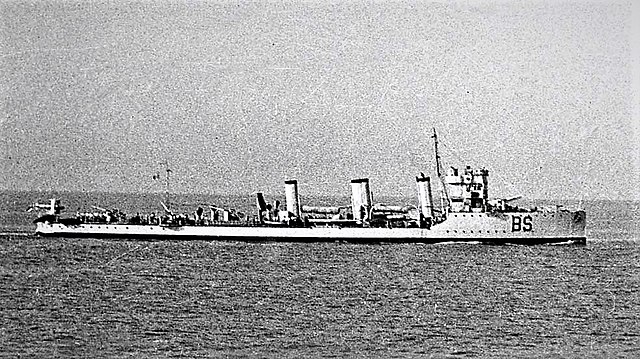
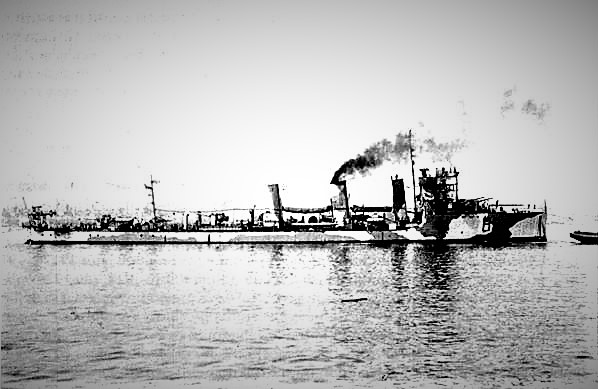
Bassini in various phases of her service
 Giuseppe La Masa (LM)
Giuseppe La Masa (LM)
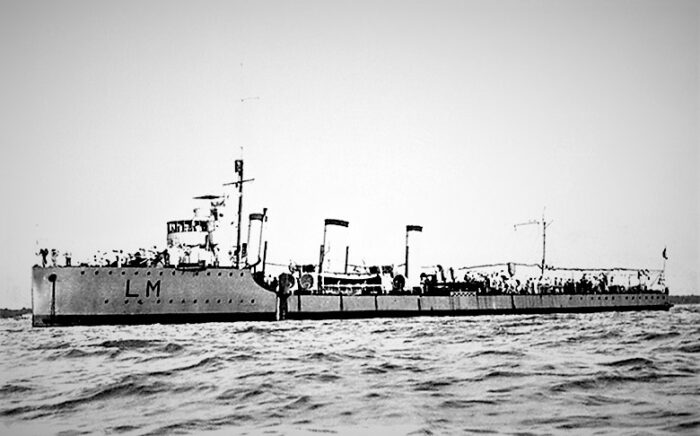
Giuseppe La Masa was laid down at Odero, Sestri Ponente on 1 September 1916, launched on 6 September 1917 and completed on 28 September 1917. On the night of 1–2 July 1918 she joined Audace, Francesco Stocco, Giovanni Acerbi, Giuseppe Missori, Giuseppe Sirtori, and Vincenzo Giordano Orsini for a distant support to TBs towing dummy landing pontoons for a simulated amphibious landing ads distraction to Austro-Hungarian troops as a shelling took plce between Cortellazzo and Caorle. She sailed out to intercept the Austro-Hungarian air raid on Venice on 2 July. There was a brief exchange on the destroyer Balaton and later La Masa, Audace, and Missori fired on Csikós and the two TB,s scoring a hit on Csikós. They withdrew to Pola.
The Armistice of Villa Giusti was signed on 3 November 1918, effectove on the 4th and on 3 November, La Masa sailed with Audace, Missori, Fabrizi, meeting later TBs Climene and Procione from Cortellazzo to Trieste as seen above. At 16:10 she disembarked some of the 200 Carabinieri she carried and General Carlo Petitti di Roreto, proclaiming the annexation of the city. On 5 November 1918, La Masa with Missori, the battleship Ammiraglio di Saint Bon, Abba and Rosolino Pilo entered Pola, and assisted its occupation. The situaiton ended on 11 November 1918.
On 20 August 1923 she was part of the Corfu incident, leaving Taranto with Sirtori, the Duilio and Andrea Doria, Augusto Riboty, and the DDs Papa, Cantore, Chinotto, Prestinari to Portolago, Leros (Aegean Sea) to protect the Italian Dodecanese from Greece.
On 10 June 1940 Giuseppe La Masa was based at La Spezia, 16th Torpedo Boat Squadron (Calatafimi, Castelfidardo, Curtatone, Carini, Monzambano). She performed escort missions in the Tyrrhenian Sea and was modernized, rearmed.
On 9 February 1941, Force H started Operation Grog, a naval/aerial bombardment of Genoa and La Spezia. At 11:47 HMS Ark Royal fighters shot down an Italian 287th Squadron CANT Z.506 Airone which sighted Force H before and La Masa rescued the crew in the Tyrrhenian Sea at 17:00, reporting their sighting at 17:15 for the force 45 nautical miles (83 km; 52 mi) from Cap Corse and its heading which was wrong. Admiral Angelo Iachino only had the news at 17:55, eight hours after sighting, too late for an intervention. On 8 September 1943, the armistice prompted the Germans to start Operation Achse, disarmament of all Italian armed forces, occupation of northern Italy and Aegean, and Giuseppe La Masa was undergoing overhaul at Naples, unable to sail, so she was scuttled by her crew on 11 September.
 Giacinto Carini (CA, CR)
Giacinto Carini (CA, CR)
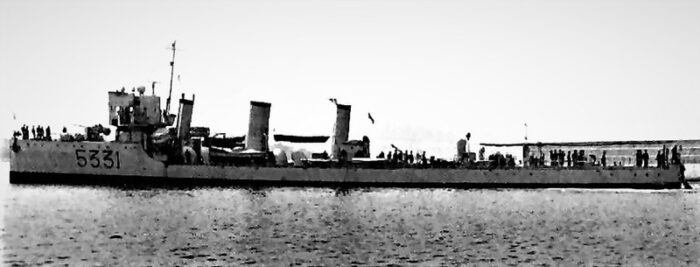
Carini post-WW2 as the minesweeper M5331
Giacinto Carini was laid down at Odero on 1 September 1916, launched on 7 November 1917 and completed on 30 November 1917. She entered service in 1918, assigned to the 4th Destroyer Squadron at Brindisi and took part in the Adriatic campaign. On 10 March 1918 she took part in the raid on Portorož (Portorose) but this was postponed due to poor weather. Same on 16 March, but adverse weather again, then 8 April 1918. But an aerial reconnaissance reported the port empty. On the night of 9–10 April 1918 Carini was part of a force of Italian and French destroyers escorting Battleships of the 2nd Naval Division from Brindisi to Taranto when on 10 April, Faulx and Mangini collided in the Strait of Otranto. Later while entered the Ionian Sea, Carini accidentally rammed Benedetto Cairoli, whuch sank off Santa Maria di Leuca. Giacinto Carini reached port to have her bow repaired until the armistice. In the interwar she was active in the Mediterranean Sea and Red Sea, taking part in the Corfu incident on 30 August 1923, escorting a large force to occupy the island, arriving on 31 August and asking the Greek governor to surrender. This was refused and she, with the rest of the fleet opened fire at 16:00, and reduced the Old Fortress and New Fortress to rubble after 15 minutes. It was later accepted and the Italian expeditionary force, the 48th Infantry Regiment “Ferrara” with eight 75 mm guns and an 5000 strong infantry brigade landed with sailors parties sent by any ships, including Carini. Giacinto Carini and four destroyers remained with an armored cruiser, submarines, and MAS boats after the fleet left in case of a Greek intervention to retake the island. Once agreement was reached between gocernments, she left Corfu on 29 September 1923.
She served under captain Carlo Bergamini (future admiral and CiC) from June to 23 December 1926. In 1929 she was reassigned with Bassini, La Farina, and Fabrizi in the newly formed 5th Destroyer Squadron and 6th Destroyer Squadron with Carlo Mirabello forming the 3rd Flotilla in Taranto. Bergamini returned from 16 July 1931 to 24 March 1932, testing a fire-control system, the “Galileo–Bergamini” system, which he designed. In 1940 she served under Capitano di corvetta Lorenzo Bezzi in the 16th Torpedo Boat Squadron (with La Masa), on escort duty. On 9-15 June 1940 she joined Curtatone and Sirio escorting the minelayers Crotone, Elbano Gasperi, Fasana, and Giuseppe Orlando to lay a minefield off Elba. Caruni was modernized and in April 1941, received a EC3/ter Gufo radar, just created for testing, showed efficient to 12 kilometres (6.5 nautical miles; 7.5 miles).
On 11 November 1942 she collided in Genoa with the sailing vessel V 208 Araldo (patrol vessel). On 8 September 1943 she avoided capture while sailing with Nicola Fabrizi to Malta, handed over on 21 September and returned to Italy on 5 October 1943, starting escorts under Co-belligerence until May 1945. She was reclassified as a minesweeper in 1953, stricken on 31 December 1958, pontoon GM 517 for the Corps of Naval Crews at La Maddalena, Sardinia, until sold for BU on May 1963.
 Benedetto Cairoli (BC)
Benedetto Cairoli (BC)
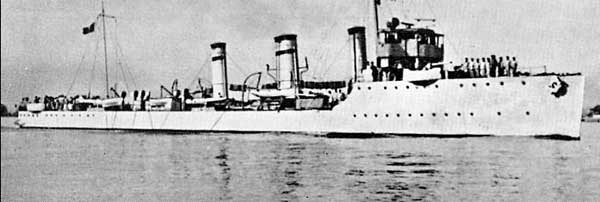
Benedetto Cairoli was laid down at Odero on 1 September 1916, launched on 28 December 1917 and completed on 3 February 1918. She was assigned to the 4th Destroyer Squadron at Brindisi and in the night of 9–10 April 1918 she took part of the operation consisting in moving the 2nd Italian Battleship Division from Brindisi to Taranto. On 10 April after the loss of Faulx after a collision herself while in the Ionian Sea was rammed by Giacinto Carini. The shock rupture her hull and the bulkheads held for a time to evacuated her crew but she sank a few hours later off Santa Maria di Leuca. The RAN destroyer HMAS Torrens rescued her survivors but she lost one in the heavy seas.
 Angelo Bassini (BS)
Angelo Bassini (BS)
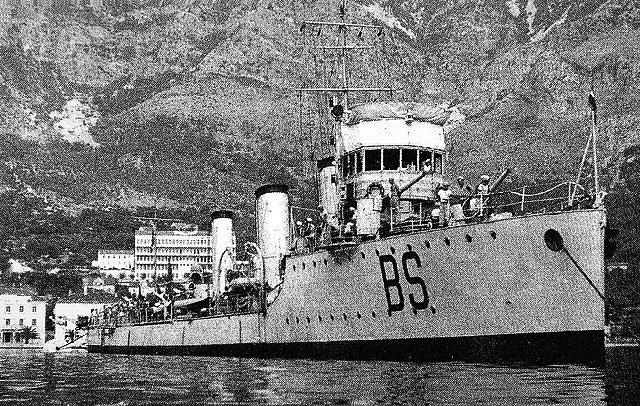
Angelo Bassini was laid down at Odero on 2 October 1916, launched on 28 March 1918 and completed on 1 May 1918. She took part in the final months of World War I, Adriatic campaign but no significant operation. In 1922 she was awarded battle ensigns by the city council of La Spezia. In 1929 with was part of thr 5th Destroyer Squadron, 3rd Flotilla, 2nd Torpedo Boat Division in Taranto. In 1940 June she was on escort duty on shipping routes in the southern Adriatic and Italy-Greece.
From 20 August she was based at Brindisi, assigned to Maritrafalba with other ships and the 13th MAS Squadron, active on 5 September 1940. On 17 September she escorted Filippo Grimani (postal vessel) from Brindisi to Durrës and Piero Foscari to Brindisi. On 18 September sme for Piero Foscari (Brindisi-Durrës) and Filippo Grimani (Durrës-Brindisi) and other missions. On 25 September she escorted Nita, Oreste, and Premuda carrying supplies from to Durrës and other missione=s until Maritrafalba was disbanded on 12 October 1940, reconstituted on 21 October. She was deployed with the Forza Navale Speciale to occupy Corfu under Ammiraglio di squadra Vittorio Tur (Bari, Taranto, 2 destroyers, 6 TBs) escorting troopships with the 47th Infantry Division “Bari” and RM “San Marco” on Corfu on 28 October as the Greco–Italian War broke out, postponed due to rough seas on 30, 31 October, 2 November and cancelled as the Greek front was frozen.
Angelo Bassini returned to escort on the Albanian shipping routes in November but was dispatched on 28 November for a bombardment of Greek positions, northeastern coast of Corfu.
On 1 January 1941 at 02:00, Angelo Bassini left Bari with the auxiliary cruiser Barletta to escort Aventino and Quirinale, Città di Savona carrying 2,884 soldiers to Durrës. Other escort missions went on (see the article for more).
On 8 October 1942, she sailed to Pylos to supply the Greek bases of the Regia Marin and on the 10th in ppor weather and rough seas, Ionia, she zigzagged on Enrichetta′s bow, but later lost the steamer in the weather, later discovered wreckage, as she was sunk by HMS P43 (later HMS Union). She rescued survivors and left at 17:30 and arrived at Pylos at 19:10.
From February 1943 she was used for the rapid transportation of troops and supplies to Tunisia. On 23 April 1943 she rescued the crew of HMS Sahib which earlier torpedoed Galiola and was hit by combined air and sea attacks. On 28 May 1943 she was in Leghorn, Livorno when bombed by 92 USAF Liberators. She suffered a devastating bomb hit, capsized, and sank but her crew survived, mostly on land when it happened. She was stricken on 18 October 1946, refloated in 1946 scrapped.
 Nicola Fabrizi (FB)
Nicola Fabrizi (FB)
Nicola Fabrizi was laid down at Odero on 1 September 1916, she was launched on 8 July 1918 and completed on 12 July 1918. She took part in the final months of the Adriatic campaign. She was part of the expoedition to Trieste before the armistice of 11 November 1918.
In 1929, she was in the 5th Destroyer Squadron, 3rd Flotilla, 2nd Torpedo Boat Division in Taranto.
In October 1940 she was assigned to the Forza Navale Speciale to occupy Corfu but plans were eventuallyt postponed (see above). On 11 November under command of reserve Tenente di vascello Giovanni Barbini she escorted a convoy of four merchant ships to Italy from Albania and that night thy were intercepted by the 7th Cruiser Division (HMS Ajax, Orion, HMAS Sydney, HMS Mohawk and HMS Nubian) in the Strait of Otranto and the co,voy was spotted at 8 knots at 01:15 on 12 November. All four merchant ships were badly damaged or sunk, the auxiliary Ramb III withdrew and Nicola Fabrizi attempted a bold counterattack, clsoing for torpedoes, shelled by Orion, but when closed, had had her torpedo tubes out of action. She resumed fire with her main guns and trying to draw them on an Italian defensive minefield off the Albanian coast. However the latter folded, after destroying the convoy at 01:53. She had 11 killed and 17 wounded when reaching Vlorë. Lt. Barbini, who refused to be treated for his wounds until the end was awarded the Medaglie d’Oro.
She wa slater modernized and reumed escorts. On 30 January with Bassini, and the auxiliary cruiser Brindisi she left Brindisi to escort 2 steamers to Vlorë and was later sent to the Tyrrhenian Sea for more missions. Nicola Fabrizi avoided capture and arrived at Malta after the September armistice, handed over on 21 September, returned to Italy and took on more missions in the Co-belligerent Navy through the end of the war in Europe. She became a minesweeper in 1953, stricken on 1 February 1957 and scrapped.
 Giuseppe La Farina (FR, LF)
Giuseppe La Farina (FR, LF)
Giuseppe La Farina was laid down at Odero on 29 December 1917, launched on 12 March 1919 and completed on 18 March 1919, too late for WW1. She took part in the expedition after the Corfu incident alongside the BBs Conte di Cavour and Giulio Cesare, armored cruisers San Giorgio and San Marco, destroyers, TBs and MAS, submarines Agostino Barbarigo and Andrea Provana from Taranto and arriving on 31 August 1923. Giuseppe La Farina and the other four destroyers stayed behind when the fleet left Corfu and only left on 29 September 1923.
In 1929 she was part of the 5th Destroyer Squadron in Taranto. Her unit served as an escort on shipping routes between Italy and Libya. On 4 November 1940 she escorted the steamers Pallade and Snia Amba when attacked by HMS Tetrarch which badly damaged Snia Amba off Benghazi. She later had a revision of her armament. On 18 April 1941 she departed Palermo to escort the steamers Isarco, Maddalena Odero, and Nicolò Odero to Tripoli, arrving on 21 April 1941.
On 3 May she escorted Luisiano to Trapani in Sicily when at 05:30 on 4 May she struck a mine off Tunisia (Kerkennah shallows), which broke her in two. She sank in two minutes with 61 of her 128 crew after 35 escort missions, 12 antisubmarine patrols.
 Agostino Bertani (CS) (after 1921: Enrico Cosenz, EC)
Agostino Bertani (CS) (after 1921: Enrico Cosenz, EC)
Agostino Bertani was laid down at Odero on 23 December 1917, launched on 6 June 1919 and completed on 13 June 1919. She missed WWI but on the night of 7–8 October 1919, she was moored at the Molo Sanità (Sanità Pier) in Trieste when officers sided with D’Annunzio seized control of her, to sail to Fiume. The “Bloody Christmas” fighting ended on 29 December 1920 with D’Annunzio’s defeat and establishment of the Free State of Fiume. Agostino Bertani surrendered to Italian forces and by mid-January 1921 was moved to Pola, stricken temporarily then reinstated as Enrico Cosenz.
In June 1940 she was in Brindisi with the 7th Torpedo Boat Squadron (Angelo Bassini, Giacomo Medici, Nicola Fabrizi). She mad emany escort missions between Italy and North Africa or the Tyrrhenian Sea. By late September 1940 when escorting a 700 GRT steamship in the Eastern Mediterranean, submarine torpedoed her and she counterattacked with depth charges reporting her sunk but it was never confirmed on the British side. In October 1940 she escorted the merchant Col di Lana from Tripoli to Naples. She had a modernizaiton overhaul and on 9 April 1941 left Naples with Dardo and two TBs to escort Andrea Gritti, Barbarigo, Burmania, Rialto, and Sebastiano Venier to Tripoli without incident.
At 05:30 on 21 November 1941 she escorted from Naples with Nicoloso da Recco escorting Monginevro and the tanker Iridio Mantovani to Libya when at the same time the distant cover force saw the cruiser Trieste badly damaged as well the light cruiser Luigi di Savoia Duca degli Abruzzi.
At 04:50 on 21 January 1942, she collided with the auxiliary minesweeper G 76 America while off Trapani, Sicily. At 21:00 on 22 February 1942, she rammed the steamship Luisa loaded with coal in the Strait of Messina, which sank in 20 minutes. On 17 October 1942 she left Naples with Maestrale and Grecal, Sirtori to escort the tanker Panuco to Tripoli when on 18 October they were attacked by HMS Una (unsuccessfully) north of Catania and then by Allied aircraft so they had to divert to Taranto.
After 8 September 1943, she steamed to Malta to avoid capture, but on 25 September collided with the steamer Ulisse off Lastovo (Lagosta), Adriatic Sea off Dalmatia and lost power. She was caught two days later by the Lufwaffe, and so badly damaged she was scuttled.
 Giacomo Medici (MD)
Giacomo Medici (MD)
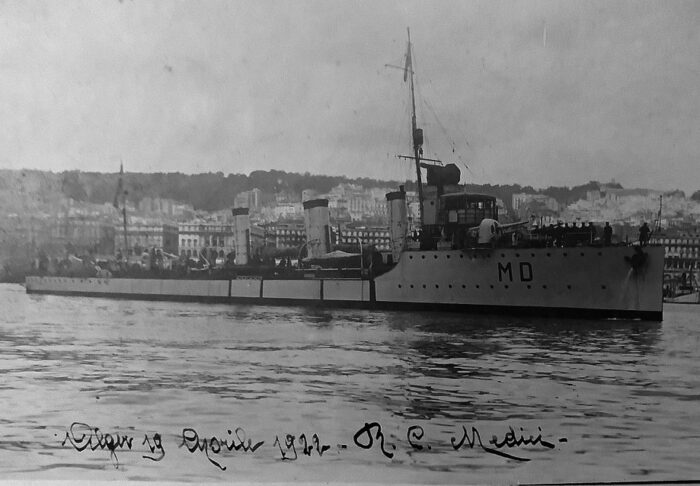
Giacomo Medici was laid down at Odero on 2 October 1916, launched on 6 September 1918 and completed on 13 September 1919. During the Corfu incident she took part in the expedition on 30-31 August 1923 and the bombardment of the Old Fortress and New Fortress and later remained at Corfu until 29 September.
In June 1940 she wa spart of the 7th Torpedo Boat Squadron, escorting convoys between the southern Adriatic Sea, Italy and Greece until September 1942.
In August she was pat of the Maritrafalba, Albanian Higher Traffic Command. Full details of her mission here.
Giacomo Medici was assigned to the Forza Navale Speciale to occupy Corfu, operation postponed and later cancelled, and later resumed escorts, returning to the Maritrafalba. On the afternoon of 30 August 1941 she rescued from rafts 20 survivors of the steamer Cilicia sunk on in the Ionian Sea and was later modernized. She was reassigned to convoy routes between Italy and North Africa in late 1942 and until mi-1943. On 16 April 1943, she was moored at Catania in Sicily, when destroyed by B-24 Liberator bombers. She was truck near her bridge and sank by the bow, rolled to starboard and capsized. Stricken 18 October 1946, refloated in 1952 and scrapped.

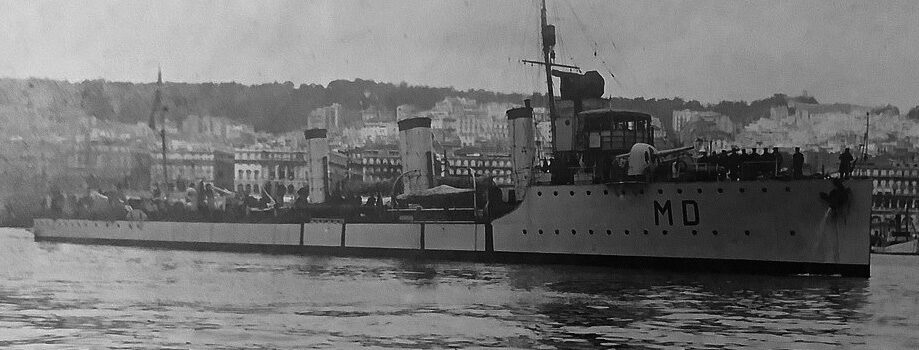
 Latest Facebook Entry -
Latest Facebook Entry -  X(Tweeter) Naval Encyclopedia's deck archive
X(Tweeter) Naval Encyclopedia's deck archive Instagram (@navalencyc)
Instagram (@navalencyc)





 French Navy
French Navy Royal Navy
Royal Navy Russian Navy
Russian Navy Armada Espanola
Armada Espanola Austrian Navy
Austrian Navy K.u.K. Kriegsmarine
K.u.K. Kriegsmarine Dansk Marine
Dansk Marine Nautiko Hellenon
Nautiko Hellenon Koninklije Marine 1870
Koninklije Marine 1870 Marinha do Brasil
Marinha do Brasil Osmanlı Donanması
Osmanlı Donanması Marina Do Peru
Marina Do Peru Marinha do Portugal
Marinha do Portugal Regia Marina 1870
Regia Marina 1870 Nihhon Kaigun 1870
Nihhon Kaigun 1870 Preußische Marine 1870
Preußische Marine 1870 Russkiy Flot 1870
Russkiy Flot 1870 Svenska marinen
Svenska marinen Søværnet
Søværnet Union Navy
Union Navy Confederate Navy
Confederate Navy Armada de Argentina
Armada de Argentina Imperial Chinese Navy
Imperial Chinese Navy Marinha do Portugal
Marinha do Portugal Mexico
Mexico Kaiserliche Marine
Kaiserliche Marine 1898 US Navy
1898 US Navy Sovietskiy Flot
Sovietskiy Flot Royal Canadian Navy
Royal Canadian Navy Royal Australian Navy
Royal Australian Navy RNZN Fleet
RNZN Fleet Chinese Navy 1937
Chinese Navy 1937 Kriegsmarine
Kriegsmarine Chilean Navy
Chilean Navy Danish Navy
Danish Navy Finnish Navy
Finnish Navy Hellenic Navy
Hellenic Navy Polish Navy
Polish Navy Romanian Navy
Romanian Navy Turkish Navy
Turkish Navy Royal Yugoslav Navy
Royal Yugoslav Navy Royal Thai Navy
Royal Thai Navy Minor Navies
Minor Navies Albania
Albania Austria
Austria Belgium
Belgium Columbia
Columbia Costa Rica
Costa Rica Cuba
Cuba Czechoslovakia
Czechoslovakia Dominican Republic
Dominican Republic Haiti
Haiti Hungary
Hungary Honduras
Honduras Estonia
Estonia Iceland
Iceland Eire
Eire Equador
Equador Iran
Iran Iraq
Iraq Latvia
Latvia Liberia
Liberia Lithuania
Lithuania Mandchukuo
Mandchukuo Morocco
Morocco Nicaragua
Nicaragua Persia
Persia San Salvador
San Salvador Sarawak
Sarawak Uruguay
Uruguay Venezuela
Venezuela Zanzibar
Zanzibar Warsaw Pact Navies
Warsaw Pact Navies Bulgaria
Bulgaria Hungary
Hungary

 Bundesmarine
Bundesmarine Dutch Navy
Dutch Navy Hellenic Navy
Hellenic Navy Marina Militare
Marina Militare Yugoslav Navy
Yugoslav Navy Chinese Navy
Chinese Navy Indian Navy
Indian Navy Indonesian Navy
Indonesian Navy JMSDF
JMSDF North Korean Navy
North Korean Navy Pakistani Navy
Pakistani Navy Philippines Navy
Philippines Navy ROKN
ROKN Rep. of Singapore Navy
Rep. of Singapore Navy Taiwanese Navy
Taiwanese Navy IDF Navy
IDF Navy Saudi Navy
Saudi Navy Royal New Zealand Navy
Royal New Zealand Navy Egyptian Navy
Egyptian Navy South African Navy
South African Navy






























 Ukrainian Navy
Ukrainian Navy dbodesign
dbodesign